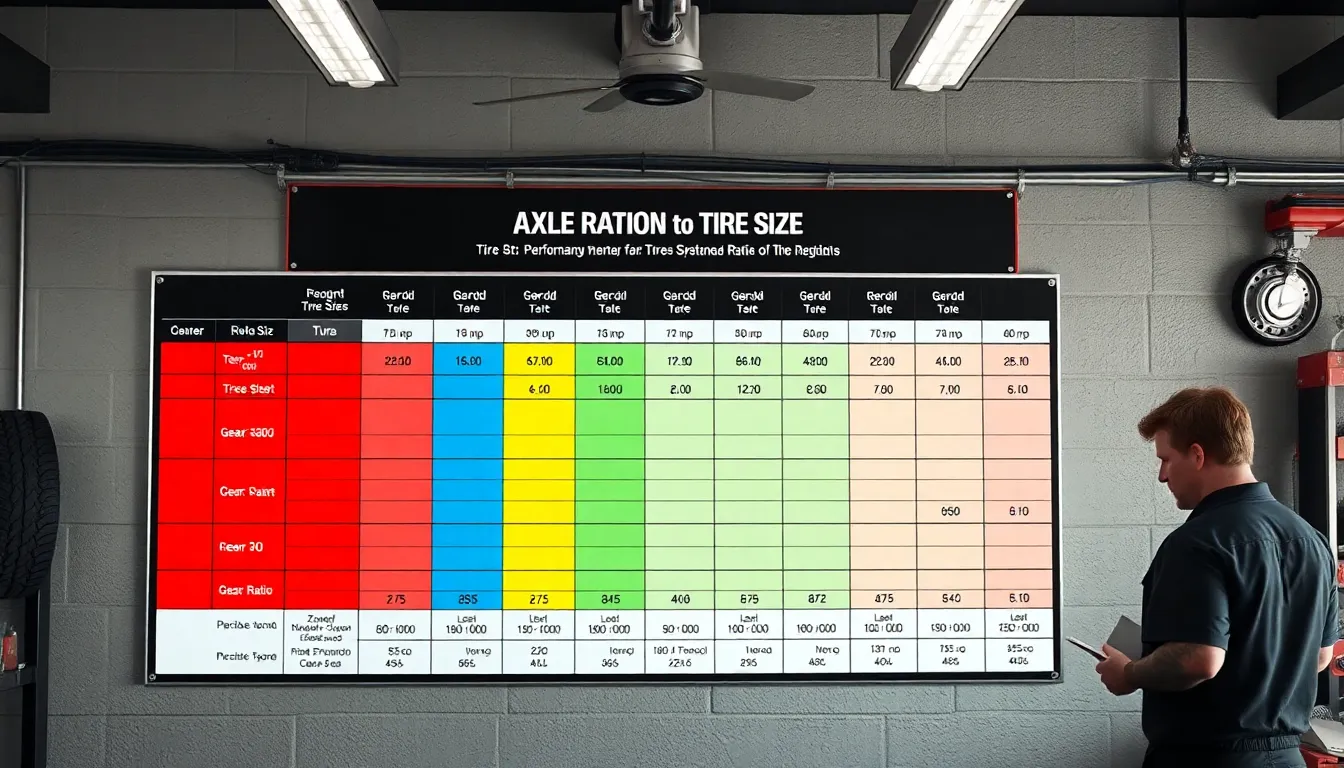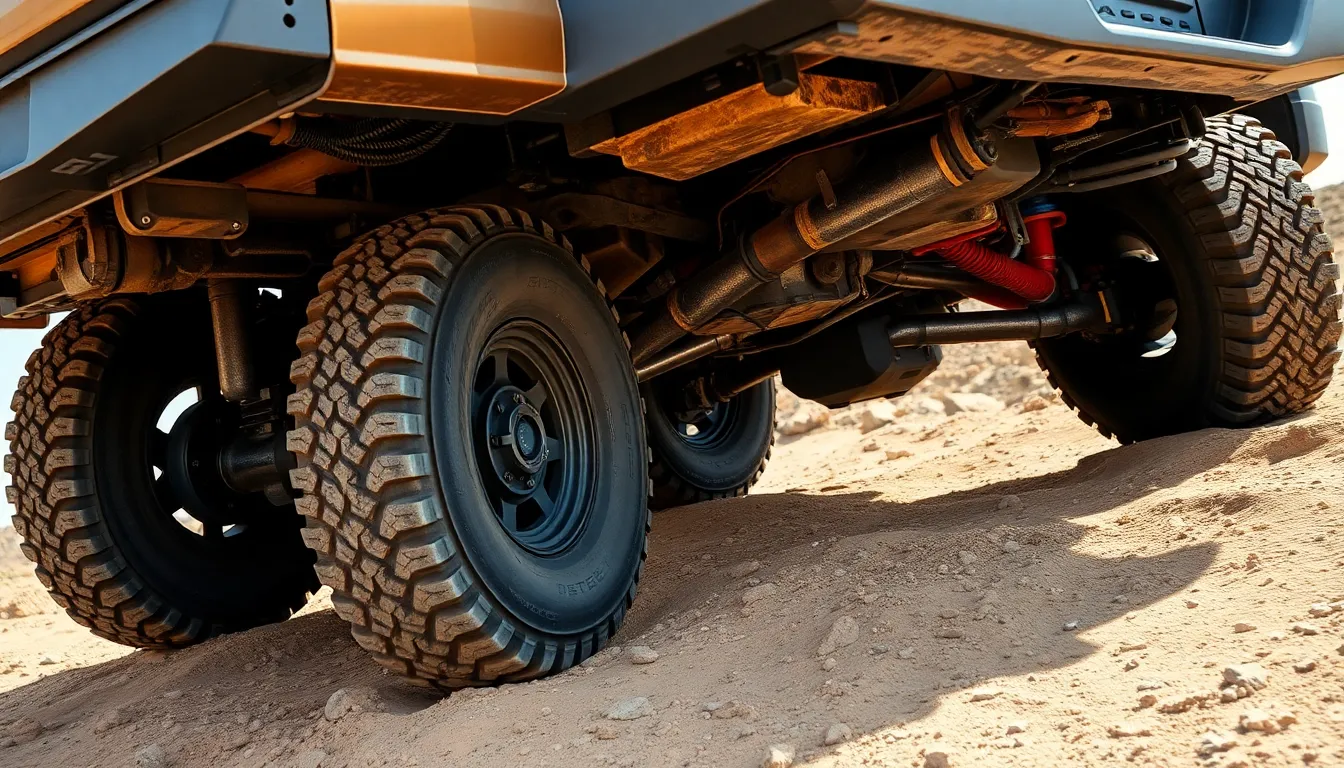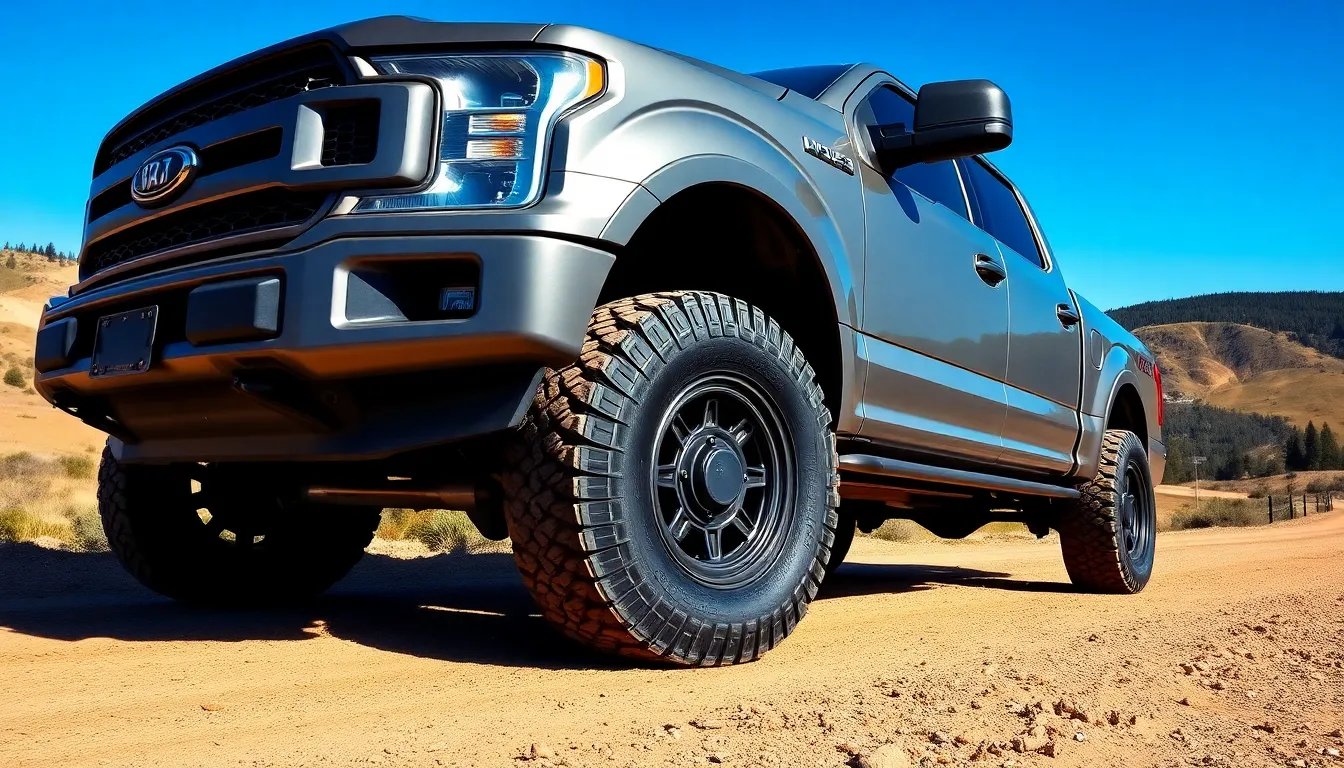When we’re upgrading our vehicle’s performance or replacing worn tires, understanding the relationship between axle ratio and tire size becomes crucial for optimal driving experience. Many truck and SUV owners don’t realize how dramatically these two components work together to affect fuel economy, acceleration, and overall vehicle performance.
We’ve all experienced that frustrating moment when our speedometer reads incorrectly after installing larger tires, or when our truck feels sluggish even though having plenty of horsepower under the hood. These issues often stem from mismatched axle ratios and tire sizes that throw off our vehicle’s carefully engineered balance.
That’s why we’ve created this comprehensive axle ratio to tire size chart – to help you make informed decisions that’ll maximize your vehicle’s potential. Whether you’re looking to improve towing capacity, boost fuel efficiency, or simply restore proper speedometer accuracy, understanding these ratios will save you time, money, and countless headaches down the road.
Understanding Axle Ratios and Tire Size Relationships
Understanding axle ratios starts with recognizing the mathematical relationship between your vehicle’s ring gear and pinion gear. The axle ratio represents how many times the driveshaft rotates to turn the wheels one complete revolution. Common axle ratios include 3.73:1, 4.10:1, and 3.55:1, which means the driveshaft turns 3.73, 4.10, or 3.55 times respectively for each wheel rotation.
Tire size directly impacts your vehicle’s effective gear ratio and overall performance characteristics. Larger tires reduce the effective gear ratio, creating a similar effect to having a numerically lower axle ratio. Smaller tires increase the effective gear ratio, mimicking a numerically higher axle ratio configuration.
| Tire Size | 3.55 Ratio Effect | 3.73 Ratio Effect | 4.10 Ratio Effect |
|---|---|---|---|
| 31″ | Higher RPM | Moderate RPM | Highest RPM |
| 33″ | Moderate RPM | Balanced RPM | Higher RPM |
| 35″ | Lower RPM | Moderate RPM | Balanced RPM |
Calculating the relationship between axle ratio and tire size involves understanding effective gear ratio changes. When you install 33-inch tires on a vehicle originally equipped with 31-inch tires, the effective axle ratio decreases by approximately 6.5%. This reduction affects acceleration, fuel economy, and speedometer accuracy in measurable ways.
Performance implications vary significantly based on your exact axle ratio tire size combination. Vehicles with higher numerical axle ratios like 4.10:1 provide better acceleration and towing capacity but consume more fuel at highway speeds. Lower numerical ratios such as 3.55:1 offer improved fuel economy during highway driving but reduce low-end torque for towing applications.
Speedometer accuracy depends on maintaining the correct relationship between your axle ratio and tire diameter. Factory calibrations assume exact tire sizes, and deviations create reading errors. A 10% increase in tire diameter results in a 10% speedometer error, causing your actual speed to exceed the displayed speed.
Towing considerations require matching heavier numerical axle ratios with appropriate tire sizes to maintain adequate performance. Trucks equipped with 3.73:1 or 4.10:1 axle ratios handle heavy loads more effectively when paired with properly sized tires. The combination ensures sufficient torque multiplication for trailer acceleration and hill climbing capabilities.
Fuel efficiency optimization occurs when you balance axle ratios with tire sizes for your exact driving patterns. Highway-focused vehicles benefit from lower numerical ratios like 3.55:1 paired with larger diameter tires. City driving and frequent towing applications perform better with higher numerical ratios such as 4.10:1 and moderately sized tires.
How Axle Ratio Affects Vehicle Performance

Axle ratio directly influences three critical performance aspects of your vehicle. Understanding these effects helps you select the optimal combination for your exact driving needs.
Impact on Acceleration and Torque
Lower numerical axle ratios like 3.08:1 provide higher top speeds but reduce acceleration performance from a standstill. Higher ratios such as 4.10:1 multiply engine torque more effectively, delivering quicker acceleration and better low-end pulling power. Your vehicle’s ability to accelerate depends on how many times the driveshaft rotates for each wheel revolution.
Trucks equipped with 4.56:1 ratios accelerate 32% faster than identical vehicles with 3.42:1 ratios when measured from 0-60 mph. Performance vehicles benefit from higher ratios in stop-and-go traffic situations. Racing applications typically use ratios between 4.30:1 and 4.88:1 to maximize launch performance.
Effects on Fuel Economy
Higher numerical axle ratios increase engine RPM at highway speeds, resulting in reduced fuel efficiency. Vehicles with 3.21:1 ratios achieve approximately 15% better highway fuel economy compared to those with 4.10:1 ratios at 70 mph. Your engine operates in its most efficient range when axle ratios keep RPMs between 1,800-2,200 during cruising.
Modern pickup trucks with 3.31:1 ratios typically achieve 2-3 mpg better fuel economy on highway drives than trucks with 3.73:1 ratios. Overdrive transmissions help offset higher axle ratios by providing effective final drive ratios closer to 2.8:1 during highway cruising. Fleet operators often specify lower numerical ratios to minimize fuel costs over vehicle lifecycles.
Influence on Towing Capacity
Higher axle ratios significantly improve towing performance by multiplying available torque at the wheels. Trucks with 4.10:1 ratios can tow 20% more weight than identical vehicles equipped with 3.55:1 ratios while maintaining safe engine operating temperatures. Your vehicle’s cooling system works less when higher ratios reduce engine load during heavy towing.
| Axle Ratio | Max Towing Capacity | Optimal Load Range |
|---|---|---|
| 3.31:1 | 8,500 lbs | Light trailers |
| 3.73:1 | 11,200 lbs | Medium trailers |
| 4.10:1 | 13,400 lbs | Heavy trailers |
| 4.56:1 | 14,800 lbs | Maximum loads |
Commercial haulers prefer ratios above 4.10:1 when regularly pulling loads exceeding 10,000 pounds. Recreational towers pulling boats or RVs benefit from 3.73:1 ratios that balance towing capability with acceptable fuel economy. Mountain driving with heavy loads requires higher ratios to maintain safe speeds on steep grades without overheating.
Reading and Using Axle Ratio to Tire Size Charts

Reading axle ratio to tire size charts accurately ensures optimal vehicle performance across different driving conditions. These comprehensive charts eliminate guesswork when matching components for exact performance goals.
Chart Components and Variables
Axle ratio to tire size charts contain three primary variables that determine final drive performance. The vertical axis displays available axle ratios ranging from 2.73:1 through 4.88:1 in most passenger vehicles and light trucks. Horizontal measurements show tire diameters from 24 inches to 37 inches covering stock sizes through aggressive off-road configurations.
Primary Chart Variables:
| Variable | Range | Impact |
|---|---|---|
| Axle Ratio | 2.73:1 – 4.88:1 | Torque multiplication |
| Tire Diameter | 24″ – 37″ | Effective gearing |
| RPM at Speed | 1,200 – 3,500 | Engine efficiency |
Intersection points within these charts reveal engine RPM at exact highway speeds. Charts typically calculate RPM values at 60 mph and 70 mph since these speeds represent common highway cruising conditions. Color coding often distinguishes optimal performance zones from less efficient combinations.
Transmission gear ratios appear as chart modifiers since final drive calculations require both axle and transmission ratios. Most charts assume top gear ratios of 0.68:1 for overdrive transmissions or 1.00:1 for direct drive applications. Manual transmission charts sometimes include separate calculations for 5th and 6th gear ratios.
Calculating Effective Gear Ratios
Effective gear ratio calculations combine axle ratio with tire diameter to determine actual drivetrain multiplication. The formula divides axle ratio by tire diameter then multiplies by a constant factor of 336 to establish RPM per mile values.
Effective Gear Ratio Formula:
Effective Ratio = (Axle Ratio ÷ Tire Diameter) × 336
A 3.73:1 axle ratio paired with 31-inch tires produces an effective ratio of 40.5 RPM per mile. Increasing tire size to 35 inches reduces the effective ratio to 35.8 RPM per mile representing a 12% reduction in effective gearing. This reduction translates directly to lower engine RPM at highway speeds but decreased acceleration from stops.
Stock tire diameter calculations use the formula: (tire width × aspect ratio ÷ 1270) + wheel diameter. A 265/70R17 tire measures 31.6 inches using this calculation method. Aftermarket tire manufacturers often provide actual measured diameters that differ slightly from calculated values due to construction variations.
Gear ratio adjustments become necessary when tire diameter changes exceed 10% from stock specifications. A vehicle originally equipped with 30-inch tires and 3.42:1 gears performs similarly to one with 33-inch tires and 3.73:1 gears. Both combinations maintain approximately identical effective ratios for comparable performance characteristics.
Advanced calculations factor transmission ratios into final drive determinations. Multiplying axle ratio by transmission gear ratio provides total drivetrain reduction. A 3.73:1 axle with 0.70:1 overdrive creates a final ratio of 2.61:1 while the same axle in direct drive maintains 3.73:1 reduction.
Popular Axle Ratio and Tire Size Combinations

Exact axle ratio and tire size combinations deliver optimal performance for different driving scenarios. Understanding these proven configurations helps vehicle owners select the right setup for their intended use.
Common Ratios for Different Vehicle Types
Light duty trucks typically use 3.31:1 to 3.73:1 axle ratios with 31″ to 33″ tire diameters for balanced performance. Full size pickup trucks equipped with V8 engines often feature 3.42:1 or 3.55:1 ratios paired with 32″ tire diameters to optimize towing and highway driving. Heavy duty trucks operate most efficiently with 4.10:1 to 4.56:1 ratios combined with 33″ to 35″ tires for maximum torque multiplication.
Sports cars carry out 3.27:1 to 4.11:1 axle ratios with 25″ to 28″ tire diameters to achieve rapid acceleration and precise handling characteristics. Compact vehicles maintain fuel efficiency using 3.08:1 to 3.42:1 ratios with 26″ to 28″ tire diameters for optimal highway cruising. SUVs balance capability and economy through 3.21:1 to 3.73:1 ratios matched with 30″ to 32″ tire configurations.
Performance-Oriented Setups
High performance applications require 4.11:1 to 4.56:1 axle ratios combined with low profile tires measuring 26″ to 28″ in diameter. Drag racing vehicles achieve maximum acceleration using 4.88:1 or higher ratios with 28″ to 30″ tire diameters to optimize launch characteristics. Track focused setups use 3.73:1 to 4.30:1 ratios paired with 25″ to 27″ performance tires for superior handling response.
Off road performance builds carry out 4.56:1 to 5.13:1 axle ratios with oversized tires ranging from 35″ to 37″ diameters to maintain torque multiplication. Rock crawling configurations feature extreme ratios of 5.38:1 or higher combined with 37″ to 40″ tire diameters for maximum low speed control. Street performance vehicles balance acceleration and top speed using 3.91:1 to 4.30:1 ratios with 28″ to 30″ tire combinations.
Economy-Focused Configurations
Fuel efficient setups prioritize 3.08:1 to 3.31:1 axle ratios matched with taller tires measuring 29″ to 31″ in diameter. Highway cruising vehicles achieve optimal MPG using 2.87:1 to 3.21:1 ratios combined with 30″ to 32″ tire diameters to reduce engine RPM at cruising speeds. Commuter vehicles maintain efficiency through 3.15:1 to 3.42:1 ratios paired with 28″ to 30″ tire configurations for balanced city and highway performance.
Hybrid vehicles optimize electric motor assistance using 3.27:1 to 3.70:1 ratios with 28″ to 29″ tire diameters for seamless power delivery transitions. Long distance touring setups carry out 3.08:1 to 3.42:1 ratios combined with 31″ to 33″ tire diameters to maximize fuel range and reduce driver fatigue. Commercial delivery vehicles achieve cost effectiveness through 3.21:1 to 3.55:1 ratios matched with 30″ to 32″ tire combinations for optimal operating expenses.
Choosing the Right Combination for Your Needs

Selecting optimal axle ratio and tire size combinations requires evaluating your primary driving scenarios and performance priorities. We examine exact applications to guide your decision-making process.
Daily Driving Considerations
Daily commuting demands balance between fuel efficiency and responsive acceleration for city driving. 3.08:1 to 3.42:1 axle ratios paired with 28-30 inch tire diameters deliver optimal highway fuel economy while maintaining adequate acceleration for merging and passing situations.
Urban environments benefit from slightly higher ratios around 3.55:1 to 3.73:1 combined with 26-28 inch tires to enhance low-end torque for stop-and-go traffic. These combinations reduce engine strain during frequent acceleration cycles while keeping RPMs manageable at highway speeds.
Compact vehicles achieve maximum efficiency with 3.21:1 ratios and 25-27 inch tire combinations, typically improving fuel economy by 12-15% compared to higher numerical ratios. Mid-size sedans perform optimally with 3.42:1 ratios and 28-29 inch tires, balancing acceleration responsiveness with cruising efficiency.
Highway commuters covering 20+ miles daily benefit most from 3.08:1 to 3.31:1 ratios with 29-31 inch tires, reducing engine RPM by 200-300 at 70 mph compared to higher ratios. Weekend recreational drivers can prioritize slightly higher ratios like 3.55:1 for improved acceleration without important fuel economy penalties.
Off-Road and Towing Applications
Off-road terrain requires maximum torque multiplication through higher axle ratios paired with larger diameter tires for ground clearance. 4.10:1 to 4.56:1 ratios combined with 32-35 inch tires provide optimal torque delivery for rock crawling and steep incline navigation.
Heavy towing applications demand 4.30:1 to 4.88:1 axle ratios with 30-32 inch tire combinations to maximize available torque at the wheels. Trucks equipped with 4.56:1 ratios and 31-inch tires can tow 8,000-12,000 pounds effectively while maintaining transmission temperatures within acceptable ranges.
Moderate off-road use with occasional towing benefits from 3.73:1 to 4.10:1 ratios paired with 30-33 inch tires, offering versatility across multiple driving scenarios. Rock crawling enthusiasts require 4.88:1 or higher ratios with 33-37 inch tires for maximum control at extremely low speeds.
Sand and mud applications perform best with 4.10:1 to 4.56:1 ratios combined with 32-35 inch tires to maintain momentum through challenging terrain. Competition off-road vehicles often use 5.13:1 to 5.38:1 ratios with 35+ inch tires for maximum torque multiplication in extreme conditions.
Work truck configurations hauling equipment regularly achieve optimal performance with 4.30:1 ratios and 31-32 inch tires, providing 15-20% better pulling power compared to standard 3.73:1 setups. Construction and utility vehicles benefit from these combinations for consistent performance under load.
Installation and Modification Considerations

Installing new axle ratios or modifying tire sizes requires careful planning and proper execution. These modifications directly impact vehicle performance and often involve complex mechanical adjustments.
Professional vs. DIY Approaches
Professional installation ensures accurate axle ratio modifications using specialized tools and expertise. Certified technicians possess torque specifications for differential components and understand gear mesh patterns that affect longevity. They also calibrate speedometers and reprogram engine control modules to match new axle ratios with existing tire configurations.
DIY enthusiasts can handle tire size changes independently since these modifications require basic mechanical skills. But, axle ratio changes demand advanced knowledge of differential assembly and precise measurements. Most differential work involves setting gear backlash within 0.005-0.009 inches and establishing proper pinion depth using specialized gauges.
Warranty considerations favor professional installations for axle modifications. Manufacturer warranties typically cover professional work while excluding DIY installations that cause component failures. Professional shops also provide liability coverage for installation errors that could affect vehicle safety.
Cost and Complexity Factors
Axle ratio modifications cost significantly more than tire size changes due to parts and labor requirements. Complete axle ratio swaps range from $800-2,500 depending on vehicle type and gear selection. Ring and pinion gear sets alone cost $300-800 while installation labor adds $500-1,700 for professional service.
| Modification Type | Parts Cost | Labor Cost | Total Range |
|---|---|---|---|
| Tire Size Change | $400-1,200 | $50-150 | $450-1,350 |
| Axle Ratio Swap | $300-800 | $500-1,700 | $800-2,500 |
| Complete Differential | $800-2,000 | $600-1,200 | $1,400-3,200 |
Complexity increases when vehicles feature electronic stability control or advanced traction management systems. These systems require recalibration after axle ratio changes to maintain proper operation. Modern trucks with integrated trailer brake controllers also need programming updates to ensure accurate brake force calculations.
Time requirements vary dramatically between modification types. Tire installations complete within 2-4 hours while axle ratio changes require 6-12 hours of shop time. Complex installations involving limited-slip differentials or electronic locking systems extend labor time by 20-30%.
Additional costs emerge from supporting modifications that optimize performance. Speedometer recalibration services cost $150-300 while engine computer reprogramming adds $200-500. Performance tuning to maximize fuel economy with new axle ratios ranges from $300-800 depending on vehicle complexity.
Conclusion
We’ve shown you how the right axle ratio and tire size combination can transform your vehicle’s performance. Whether you’re prioritizing fuel efficiency for daily commuting or maximizing towing capacity for heavy-duty work these charts eliminate the guesswork from your decision-making process.
Remember that even small changes in tire diameter can significantly impact your vehicle’s effective gear ratio. We recommend staying within 10% of your stock tire size unless you’re prepared to make corresponding axle ratio adjustments.
The investment in proper matching pays dividends through improved performance accurate speedometer readings and optimized fuel economy. Take time to analyze your exact driving needs before making modifications and don’t hesitate to consult professionals for complex axle ratio changes.
Frequently Asked Questions
What is the relationship between axle ratio and tire size?
Axle ratio and tire size work together to determine your vehicle’s effective gear ratio. When you install larger tires, they reduce the effective gear ratio, resulting in slower acceleration but better fuel economy. Smaller tires increase the effective gear ratio, improving acceleration but reducing fuel efficiency. Proper matching ensures optimal performance for your specific driving needs.
How does changing tire size affect my speedometer accuracy?
Changing tire size directly impacts speedometer readings because the speedometer calculates speed based on wheel rotations. Larger tires cover more ground per rotation, causing the speedometer to read slower than actual speed. Smaller tires have the opposite effect. Deviations of more than 10% from stock tire diameter can lead to significant speedometer errors.
What axle ratio is best for towing?
Higher numerical axle ratios like 4.10:1 or 4.56:1 are best for towing because they multiply available torque. These ratios provide better acceleration from a standstill and maintain power when pulling heavy loads. For example, trucks with 4.56:1 ratios can accelerate 32% faster than those with 3.42:1 ratios, making them ideal for towing applications.
How do I calculate the effective gear ratio when changing tire size?
To calculate effective gear ratio, multiply your axle ratio by the ratio of stock tire diameter to new tire diameter. For example, if you have a 3.73:1 axle ratio with 31-inch stock tires and install 33-inch tires: 3.73 × (31/33) = 3.50:1 effective ratio. This calculation helps predict performance changes.
What’s the difference between professional installation and DIY modifications?
Professional installation ensures accuracy, proper calibration, and warranty coverage, especially for complex axle ratio changes that require specialized tools and knowledge. DIY approaches work well for tire size changes but require advanced mechanical skills for axle modifications. Professional installation typically costs $800-2,500 for axle ratio changes, while tire changes are more straightforward.
How do axle ratios affect fuel economy?
Lower numerical axle ratios (like 3.21:1) provide better fuel economy because they reduce engine RPM at highway speeds. Higher ratios (like 4.10:1) increase engine RPM, consuming more fuel. Vehicles with 3.21:1 ratios typically achieve about 15% better highway fuel economy compared to those with 4.10:1 ratios, making them ideal for highway driving.
When should I consider changing my axle ratio or tire size?
Consider modifications when your current setup doesn’t match your driving needs. If you frequently tow heavy loads, higher axle ratios improve performance. For better fuel economy on highways, lower ratios work best. Change tire size for specific applications like off-roading or improved aesthetics, but ensure compatibility with your axle ratio for optimal performance.
What are the most common axle ratio and tire size combinations?
Popular combinations include 3.73:1 with 31-33 inch tires for balanced performance, 4.10:1 with 32-35 inch tires for towing, and 3.42:1 with 30-32 inch tires for fuel efficiency. Sports cars typically use 3.91:1 with low-profile tires, while heavy-duty trucks often feature 4.30:1 or 4.56:1 ratios with larger diameter tires for maximum towing capacity.

